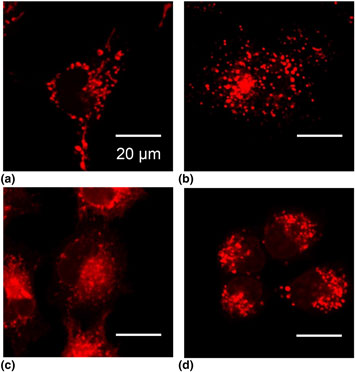Article contents
Mitochondrion-selective hemicyanine dyes suitable for fiber laser excitation two-photon microscopy
Published online by Cambridge University Press: 03 September 2018
Abstract

We investigate the two-photon absorption characteristics of hemicyanine dyes that exhibit a one-photon absorption at around 500 nm. The dyes exhibited two-photon-induced fluorescence upon irradiation with an Yb-doped femtosecond fiber laser operating at 1030 nm. Among the dyes, 4-[4-[4-(dimethylamino)phenyl]-1,3-butadienyl]-1-ethyl-pyridinium perchlorate exhibited the most efficient two-photon-induced fluorescence at 1030 nm. Since these dyes possess cationic moiety, the dyes accumulated in the mitochondria of a living cell. Two-photon images of mitochondria were obtained by staining living HEK293 cells with these dyes. When 4-[4-[4-(dimethylamino)phenyl]-1,3-butadienyl]-1-ethyl-pyridinium perchlorate was employed, a two-photon-induced fluorescence image could be obtained even when a 3 mW fiber laser beam was used as the excitation source.
- Type
- Research Letters
- Information
- Copyright
- Copyright © Materials Research Society 2018
References
- 2
- Cited by





